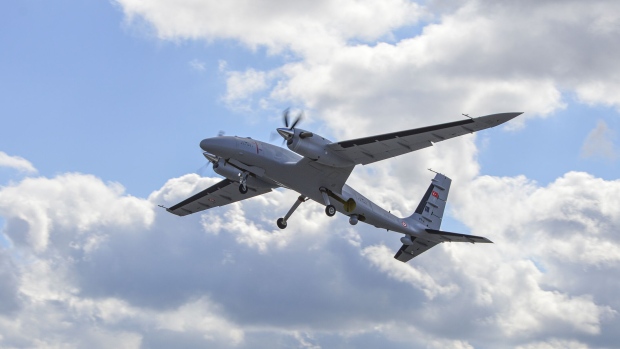Mar 29, 2024
As Drones Change Warfare in Africa, Civilians Pay the Price
, Bloomberg News

(Bloomberg) -- The first bomb exploded just a few feet from the local health clinic in a rural Mali village, sending people and animals fleeing. The second hit a nearby shed.
The drone strikes in Amasrakad village on March 16 killed 13 women and children and injured scores of others, according to Amnesty International. Hours later, an army spokesman appeared on state TV to say that it carried out a strike in the area targeting “Islamist fighters.”
The next day, another drone attack on the other side of the continent in Somalia killed more than 20 civilians, highlighting how foreign-made combat drones have changed warfare across Africa — in civil wars in Ethiopia, Sudan and Libya, and against insurgencies in Nigeria, Somalia and the Sahel region. The strikes also underscore how civilians are bearing the brunt of a lack of adequate pilot training and intelligence failures.
Over the past five years, cash-strapped African governments with poorly equipped armies have opted for drones from companies like Turkey’s Baykar and Beijing’s state-owned Aviation Industry Corp. of China — often acquired as part of bilateral security agreements, and far cheaper than traditional fighter jets. At the same time, civilian deaths from drone and air strikes soared in Africa to 1,418 in 2023 from 149 in 2020, according to data from the Armed Conflict Location & Event Data Project.
Read More: Combat Drones Made in China Are Coming to a Conflict Near You
“It’s not about the technology, it’s about how they’re used, and we’re seeing a pattern of them being used in ways they are causing an awful lot of harm to civilians,” said Nathan Allen, associate professor at the US defense department’s Africa Center for Strategic Studies.
That stems from a broader issue facing African nations — in many, civilian deaths are common during military operations, particularly those facing armed insurgencies, because of poorly trained armies or leaders with little regard for human rights.
“The failure to distinguish civilians from military targets has long been a feature of ground operations,” said Corinne Dufka, an independent analyst on the Sahel and former West Africa director at Human Rights Watch. “The killing of scores of civilians during drone attacks on crowded markets and funerals, especially in Burkina Faso, suggests the same could be true in the conduct of air ops.”
Cheaper Option
In a 2022 paper, Allen found that more than a third of African countries had acquired drones. He now believes the vast majority — and possibly every African military — has the technology, whether for surveillance or combat operations. The combat models used by most African governments — which by some estimates cost hundreds of thousands of dollars for an Iranian Shahed, $1-2 million for Wing Loong II drones and up to $6 million for Baykar’s Bayraktar TB2 — are a fraction of the cost of a fighter jet.
Baykar and AVIC didn’t respond to requests for comment.
Burkina Faso has driven the increase in civilian fatalities in recent years together with the war in Sudan, an ongoing fight against Islamist insurgents and criminal bandits in Nigeria, and in Mali, where two-thirds of all drone strikes in 2023 targeted civilians, according to Acled’s Africa regional specialist, Ladd Serwat.
Human Rights Watch has documented three drone strikes since August in Burkina Faso that killed at least 60 civilians in crowded markets. The government has said only terrorists were killed. In December, the Nigerian military took the extraordinary step of apologizing for a drone strike that killed at least 85 people during a religious ceremony.
A former senior intelligence official from an African nation that uses drones said the technology had been helpful in crushing rebellions and insurgencies in some countries, but poor pilot training and intelligence failures have meant battlefield victories have come at great human cost.
“Drones coming to the market and being acquired by governments requires more responsibility and laws to be passed to protect civilians,” while operators need more training, said Abdisalam Guled, former deputy director of Somalia’s National Intelligence and Security Agency. “It’s a new market, industry and type of weapon, but it has to come with more responsibility.”
Civilian Fatalities
Part of the reason for the proliferation of drones in Africa — and elsewhere — is Russia’s war with Ukraine, Allen said. “Particularly after the conflicts in Libya, Ethiopia and now Ukraine, which has demonstrated their significance, drone proliferation has skyrocketed,” he said.
In Ethiopia, TB2 drones acquired through a 2021 bilateral agreement with Turkey were decisive in the military’s victory over Tigrayan rebels. In recent months, the government has used its drones to crush rebellions in Oromia and Amhara regions.
Non-state actors are also employing the aircraft. In Nigeria and the Sahel, that often means jihadist groups linked to al-Qaeda or the Islamic State attaching improvised explosive devices to commercially available drones or using them for surveillance.
In Sudan, the Rapid Support Forces militia that’s fighting the army for control of the country is using more sophisticated weaponry: combat drones provided by the United Arab Emirates, according to UN investigators. The UAE denies it’s arming the RSF. Meanwhile, its rival, Sudan’s army, is employing Iranian Mohajer drones.
Read More: Iranian Drones Become Latest Proxy Tool in Sudan’s Civil War
Mali, where a military junta seized power three years ago, has acquired about a dozen Bayraktar drones since 2022, according to state media and Mali’s defense ministry.
“We have seen in many parts of Africa the growth and proliferation of drones by governments as they seek to keep a hold on power,” said Filsan Andullahi, a former Ethiopian minister who resigned in opposition to the government’s war in Tigray. “We have witnessed the use of drone technology inside communities who are completely unaware of such technology. Government’s are attacking hospitals, schools and market places, which is completely unacceptable.”
--With assistance from Firat Kozok, Zheng Wu and Diakaridia Dembele.
©2024 Bloomberg L.P.


